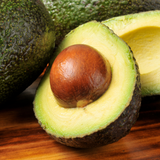A Whole Food: the Great Avocado

Avocados are a versatile and nutritious food that is beloved by many. They can be used in salads, sandwiches, smoothies, and even desserts. But what exactly is an avocado? Where does it come from? How do you tell when an avocado is ripe and how long will it stay fresh? And most importantly, what are the nutritional benefits of eating avocados? Here's everything you need to know about this delicious fruit!
What is an avocado is and where is it grown? An avocado (formally known as Persea americana) is a type of fruit native to Central America. It has green-yellow skin, with a creamy texture inside. Its flavor can range from mild to nutty depending on its ripeness. Avocados are widely grown in tropical regions around the world, including Mexico, Brazil, Peru, Colombia and even California.
When it is ripe and how long does it stay fresh? Avocado ripening depends on the variety; some are ready to eat when they are still hard while others must be left on the counter for a few days until they become soft but not mushy. Once an avocado has been picked and purchased at the store, it will continue to ripen at room temperature. Its freshness can be preserved if stored in the refrigerator once ripe. To test for ripeness before cutting into an avocado simply press gently on its skin; if it gives ever so slightly then you know your avocado is ripe!
There is an old joke, however, an avocado goes from not ready, not ready, not ready, rotten. So judging its ripeness is somewhat of an art and a learned skill. That is why buying an expensive avocado is a lot like gambling! Best to perfect your ripeness detection skills when they are on sale.
How does it look when it’s fresh? Fresh avocados have a vibrant green color with a glossy sheen to them. As they start to age, they will begin to turn brownish and then gray and eventually rotten which indicates that they are overripe and are no longer good to eat.
What are the nutritional benefits of eating avocados? Avocados are packed with nutrients! They contain healthy fats such as oleic acid which helps reduce cholesterol levels in your body as well as vitamin E which is thought to protect against cell damage caused by free radicals in your body. Additionally, avocados contain lots of fiber which aids digestion, potassium which helps regulate blood pressure levels and other functions and vitamin B6 which plays an important role in health. All these nutritional benefits make avocados one of nature’s superfoods.
How do I prepare it for eating? Preparing an avocado for eating could not be easier! Wash the fruit on the outside and dry. Then simply slice open the fruit lengthwise using a sharp knife then twist both halves apart; remove the pit by carefully hitting it with your knife then twisting again until the pit comes out. Now you can remove the skin either by peeling off each half or scooping out each half using a spoon – whichever method works best for you!
A simple recipe using an avocado: one of my favorite recipes featuring the lovely avocado is “avocado toast” – simply mash up half a ripe avocado onto two slices of whole wheat bread (or any other type of bread if preferred) then season with salt & pepper and top with red pepper flakes if desired. Enjoy!
In conclusion, avocados offer numerous benefits due their rich source of vitamins and minerals as well as their delicious flavor and creamy texture making them one of nature’s superfoods! Whether you choose to eat them raw or cooked there are endless possibilities when preparing dishes featuring this amazing fruit – so get creative and enjoy!
